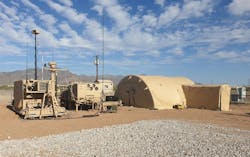Northrop Grumman to build open-systems architecture battle management system for air and missile attack
REDSTONE ARSENAL, Ala. – Battle management experts at Northrop Grumman Corp. are preparing to help military authorities quickly deal with uncertain information concerning potential air and missile attacks.
Officials of the U.S. Army Contracting Command at Redstone Arsenal, Ala., announced a $1.4 billion contract last month to the Northrop Grumman Mission Systems segment in Huntsville, Ala., for low-rate initial production and full-rate production of the Integrated Battle Command System (IBCS).
The IBCS is to be a revolutionary air command-and-control (C2) system to help air and missile defenders make quick decisions and adapt quickly to changing battlefield conditions.
The IBCS will help enhance aircraft and missile tracking and situational awareness to enable military commanders and air defenders to make critical decisions within seconds in response to air and missile attacks.
Related: Top technology challenges this decade for the warfighter
Northrop Grumman won $67 million order in late 2017 for long-lead-time materials on IBCS for the U.S. Army. Long-lead items either are difficult and time-consuming to obtain, and are funded early in the aircraft design process to keep overall production on schedule.
The IBCS represents a modular open-systems architecture to optimize limited resources and facilitate flexible defense designs, company officials say.
The IBCS enables commanders to tailor organizations, sensors, and weapons to meet the demands of diverse missions, environments, and rules of engagement not achievable today, Northrop Grumman officials say. It provides wide-area surveillance and broad protection areas by networking sensors and interceptors.
Related: Enabling technologies for airborne electronic warfare
The system enables affordable integration of current and future sensors, weapons, and modernization efforts, and helps connect systems for joint and cooperative multinational missile defense.
The IBCS is to replace seven legacy command-and-control systems with network-centric battle management to reduce single points of failure and increase the flexibility for deploying small force packages. The system creates a standard approach across forces to reduce logistics burdens and change training.
On this order Northrop Grumman will do the work at locations to be determined with each order, and should be finished by December 2026. For more information contact Northrop Grumman Mission Systems online at www.northropgrumman.com, or the Army Contracting Command-Redstone at http://acc.army.mil/contractingcenters/acc-rsa.
